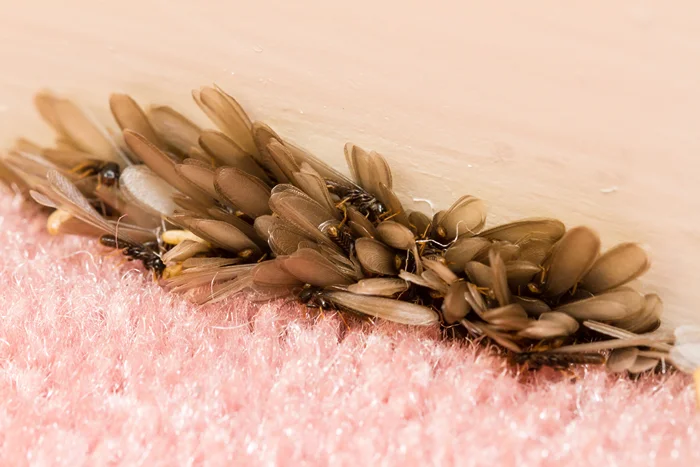


You might have seen insects that look like flies flocking your porch light. While usually harmless, these insects can look terrifying and become a nuisance as they crawl on you and flock to your indoor lighting. They might look like flying ants, but they are actually Formosan subterranean termites. Seeing them within your vicinity might mean a nearby termite activity where millions of their other colony members eat away your structural foundations.
So what should you know about the Formosan termites swarming season? Formosan termites have an annual swarming season, usually around late spring to early summer or late April through June, depending on the location. Swarming termites are harmless to humans and will eventually die of dehydration if they don't come into contact with soil. But it's a sign of a nearby termite activity of millions of other termites possibly infesting your home.
Seeing swarmers flock to light sources near your home can be inconvenient. Some homeowners tend to shrug this off, while some would do some DIY steps for getting rid of them. A winged swarmer may only look like a flying ant, but it's a type of eastern subterranean termite called Formosan subterranean termite.
To properly handle Formosan termite swarms, you should know more about their swarming season, like when they happen, how long it lasts, what winged termites do during this season, what it means to find termite swarmers, and what you should do about them.
The Formosan termite swarming season usually happens from late spring to early summer or April through June, depending on the location. The termite season in New Jersey might experience this a little earlier as the onset of swarming termites may happen around late February or March until June or July.
Most termite species, like drywood termites and dampwood termites, also have swarming seasons. There may be a few differences in the specific months they happen, but it's common during spring and summer.
If you've been away from your home when the termites swarm your light source, you might still find signs, like dead Formosan subterranean termites at your glass doors, windows, furniture pieces, and other surfaces. You may also find the wings of swarming termites around.
It may be inconvenient, but termites swarm only for about 30 to 40 minutes. They are pretty harmless – these flying termites won't bite or attack. Termite swarmers will eventually die from dehydration if they don't come into contact with soil.
A Formosan subterranean termite colony attempts to multiply during the swarming season. The colony will produce male and female winged termites that will swarm a light source in a short period to find a mate. The fertilized Formosan termite swarmer will then shed off its wings and form new colonies, worsening your termite infestation.
Some homeowners might shrug off these flying ant-looking insects, but it requires immediate intervention from your trusted pest control expert. Finding a Formosan termite swarm near your home can be a sign of termite activity within your vicinity.
As we've mentioned, a mature Formosan subterranean termite colony produces flying termites to reproduce with other termite swarms and build a new colony. Even if you've shut the doors and windows, Formosan subterranean termite swarms might still find their way into your home through small holes called "exit holes." Worker Formosan termites create them to help winged termites to exit their colony and incite a mating flight.
You may usually find these holes on the upper part of your wall. Termite swarmers might be harmless, but their presence means they have a colony nearby with thousands to millions of members. These pests might cause serious termite damage to your structural foundations, so you should seek an expert immediately and hold a termite inspection.
Now that you know the necessary information about the Formosan termites swarming season, you must learn about what you should do. You should contain the flying termites, avoid sealing off exit holes, vacuum the eastern subterranean termite swarm and throw it in a garbage bag, avoid spraying with insecticide, and call a reliable pest control expert for a possible termite infestation.
One of the things you should do is contain the Formosan termite swarmers. To do this, you can close the door of the room where the termites swarm. You may also look for the exit holes and attach plastic bags over them to catch and contain the Formosan termite swarmers. This prevents them from mating and forming new colonies.
Some property owners become tempted to seal off the exit holes they find in their structures. While this gives you the impression of containing every swarming termite in your home, sealing off exit holes might do more harm than good. Formosan termite swarmers must escape, so they will just create new exit holes.
Another best way to contain and control every Formosan termite swarmer you can find is to vacuum the swarm and throw them in the bag. By doing this tip, the Formosan termite swarms wouldn't be able to create exit holes or mate and start a new colony.
Spraying insecticide on Formosan termite swarms is also one of the first things that come into the mind of many homeowners. Spraying at eastern subterranean termite swarms is unnecessary because these pests will eventually die.
Spotting Formosan subterranean termite swarms are just one of the many signs of a termite infestation. If there are termite swarmers in your home, the chances that there are also mature colonies nearby are high.
Formosan subterranean termites can reproduce and expand their colonies easily, so you can expect a million members in a nest – this might turn into a serious termite infestation if not addressed immediately. Seek a reliable termite control expert who can conduct a thorough termite inspection to ensure that your structure is safe from these wood-destroying pests.

All termite species have a termite swarming season once their colony reaches full maturity and the weather is favorable. That's why they usually come out during spring or summer. Formosan termites usually have their swarming season around April to June or July -- some areas may experience the onset as early as February or March, like New Jersey. Spotting a Formosan termite swarmer may be a sign of termite activity.
Seek a reliable termite control expert immediately for an effective inspection and termite treatment, avoiding a serious infestation. PermaKill Exterminating is one of the trusted pest control companies in New Jersey due to its commitment to keeping homes and establishments safe and satisfied. You can have us inspect your structure for termite activity and get a free estimate today by calling us or filling out a form on our website.